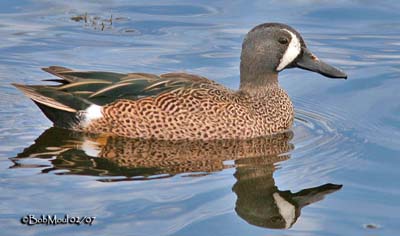
Blue-winged Teal
Anas discors
Anseriforme Order – Anatidae Family
BIOMETRICS:
Length: 37-41 cm
Wingspan: 60-64 cm
Weight: M: 273-410g - F: 266-375 g
DESCRIPTION:
Blue-winged Teal male has brown eyes, black bill, and yellow legs with dusky webbed feet. Neck and head are usually dark grey with glossy purple feathers. Crown and throat are black. We can see broad white crescent bordered with black before the eye.
Breast, belly and flanks are reddish-brown spotted darker brown, becoming as a band on the upper flanks. Tail, rump and rectrices are black. Vent is white.
Upperparts are dark brown, with extended streaked black and buff scapulars. On the wings, the primary feathers and coverts are blackish-brown. The other coverts are blue-grey with broad white patches on the greater coverts. Secondary feathers are metallic green.
Fr: Sarcelle à ailes bleues
All : Blauflügelente
Esp : Cerceta Aliazul
Ital : Anatra aliazzurre americana
Nd : Blauwvleugeltaling
Russe : Синекрылый чирок
Sd: Blåvingad årta
Photographers:
Bob Moul
Nature Photography
Tom Merigan
Tom Merigan’s Photo Galleries
Tom Grey
Tom Grey's Bird Pictures
Text and other pictures by Nicole Bouglouan
Sources :
HANDBOOK OF THE BIRDS OF THE WORLD vol 1 by Josep del Hoyo-Andrew Elliot-Jordi Sargatal - Lynx Edicions - ISBN: 8487334105
GUIDE DES CANARDS, DES OIES ET DES CYGNES – de Steve Madge - Delachaux et Niestlé - ISBN: 2603013769
THE HANDBOOK OF BIRD IDENTIFICATION FOR EUROPE AND THE WESTERN PALEARCTIC by Mark Beaman, Steve Madge - C.Helm - ISBN: 0713639601
FIELD GUIDE TO THE BIRDS OF NORTH AMERICA - National Geographic Society - ISBN: 0792274512
All About Birds (Cornell Lab of Ornithology)
The Birds of North America online

Male in winter plumage is similar to female.
Blue-winged Teal female has buffy-brown head and neck streaked darker. Crown and eyebrows are dark, with very pale patch on the sides of the bill base.
Underparts are buff speckled dark brown, with some serrations on the flanks.
Upperparts are dark brown with pale buff feathers’ tips. On the wings, primary feathers and their coverts are blackish-brown. The other coverts are blue-grey, with rather brown greater coverts and small white marking. Secondary feathers are metallic green.
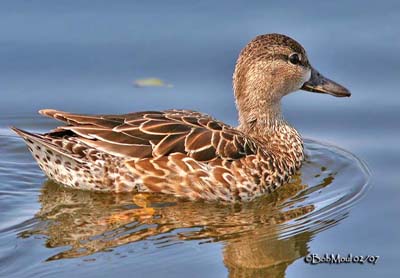
VOICE: SOUNDS BY XENO-CANTO
Blue-winged Teal is relatively silent. The male may utter a thin whistle “tsii-tsii”, given by both sexes while flying or swimming. The female utters a high-pitched “couac”.
HABITAT:
Blue-winged Teal frequents small freshwater lakes, swampy lakes, quiet rivers and small streams in open area. It also frequents cultivated areas.
This species winters on large shallow water surfaces, including marshes and rice fields, salt and brackish waters and swamps.
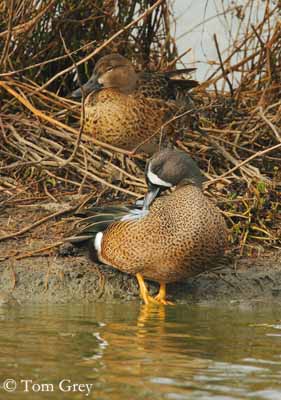
RANGE:
Blue-winged Teal is an American species. It is found through North America, from southern Alaska to centre of United States.
It winters from California to North Carolina, in Central America and South America to northern Chile and Argentina.
It may be occasionally found in Europe, Great Britain, north-western Africa, Hawaii, Aleutian Islands, Galapagos and Greenland.
BEHAVIOUR:
Blue-winged Teal forages at water surface by dabbling into the shallow vegetation. Sometimes, it plunges the head into the water while it topples its body with the tail above the surface. It is rarely submerged and dives very occasionally. This species often feeds at night.
Blue-winged Teal is often found in flocks of up to 30-40 birds, mixed with other dabbling ducks and other species, feeding in shallow lagoons.
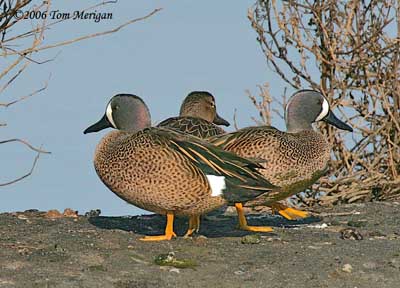
The pair-bonds are relatively strong, but the male leaves the female during the incubation.
Blue-winged Teal is often perched on stumps, rocks and tree trunks.
This species is strongly migratory.
FLIGHT:
Blue-winged Teal often flies in small groups, undulating and turning together in the same movement. The flight is fast and agile. While flying, we can see the blue speculum on the wing, making the bird unmistakable.
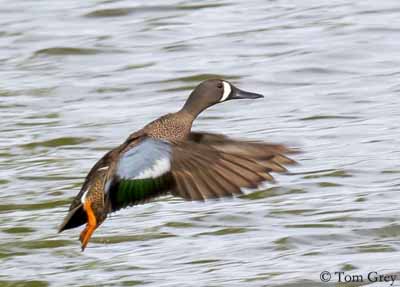
REPRODUCTION:
Breeding season starts in May. The nest is on the ground, near water but in dry place, hidden among the tall grasses. It is built by the female with vegetation found on the shores, and the interior is lined with grass and down.
Female lays 8-11 olive-white or creamy eggs. Incubation lasts about 23-24 days, by female alone. Chicks hatch synchronously.
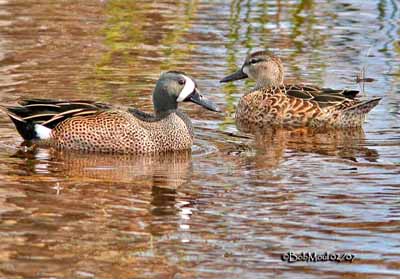
The chicks are sepia-brown with yellow spots above, whereas the underparts and head sides are pale yellow. We can see a dark eye line extending to the ear coverts. Bill and legs are dark grey.
Chicks leave the nest about 24 hours after hatching, and are able to swim and feed themselves. The female cares them during 38 to 49 days, until they fledge.
Young reach their sexual maturity at one year. They are able to migrate separately from their parents as soon as the first migration.
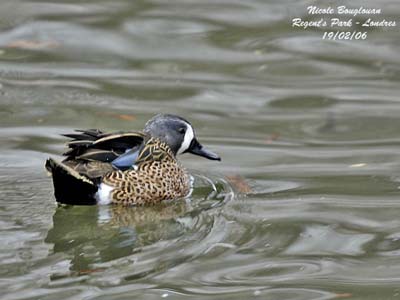
DIET:
Blue-winged Teal feeds on insects, molluscs and crustaceans, seeds, buds and ledges’ roots, weeds, aquatic plants, algae and rice.
During migrations, they feed mainly on seeds.
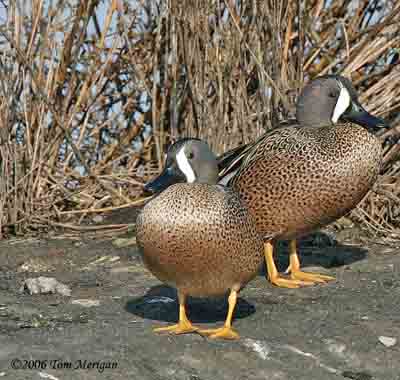
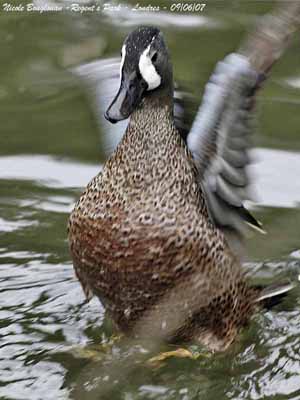
PROTECTION/THREATS/STATUS:
Changes in the habitat with drainage of wet areas and extension of agriculture are the main causes of populations’ declines.
Nests are parasitized by various ducks’ species. Eggs are eaten by several predators such as crows and small mammals.
Blue-winged Teal suffers large mortality during the migrations, due to the very long flights over water to reach South America.